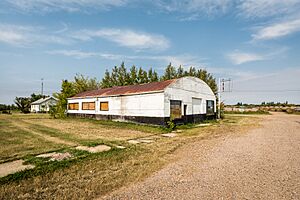Endiang facts for kids
Quick facts for kids
Endiang
|
|
|---|---|
 |
|
| Country | Canada |
| Province | Alberta |
| Census division | No. 7 |
| Municipal district | County of Stettler No. 6 |
| Government | |
| • Type | Unincorporated |
| Area
(2021)
|
|
| • Land | 0.61 km2 (0.24 sq mi) |
| Elevation | 870 m (2,850 ft) |
| Population
(2021)
|
|
| • Total | 15 |
| • Density | 24.5/km2 (63/sq mi) |
| Time zone | UTC−7 (MST) |
| • Summer (DST) | UTC−6 (MDT) |
Endiang is a small community, called a hamlet, in Alberta, Canada. It's part of the County of Stettler No. 6. You can find it about 80 kilometers (50 miles) southeast of Stettler.
In the early 1900s, Endiang was quite busy. But over time, things changed. Events like the Great Depression and World War II, along with better ways to travel, meant fewer people lived in the area.
Years ago, Endiang had many businesses. There was a post office, stores, a bank, and even a train station. Today, it still has a community hall and a restaurant.
Endiang is located in Census Division No. 7. It is also in the federal voting area known as Battle River—Crowfoot.
What is the History of Endiang?
Endiang has an interesting past. One surprising fact is that during the Cold War, it was thought to be a possible spot for a conflict. Some believed that if missiles were launched, they might meet over Endiang. This idea was even written about in a poem called "Armageddon at Endiang, Alberta".
The first settlement of Endiang started in 1910. It was about 5 kilometers (3 miles) northeast of where it is now. William Foreman created it on his land. He named it "Endiang" after a family hotel in Ontario. The name comes from the Anishinaabe language and means "our home".
This early settlement had a post office, a store, and a hall. In 1925, a new railroad was built by the CNR. It didn't go through the original settlement. So, people used horses to move the buildings to the new spot where Endiang is today.
Endiang is also known as the home of the Shaben family. Some members of this family helped build the first mosque in Alberta.
A famous person from Endiang is Darcy Tucker. He is an NHL hockey player who played for teams like Montreal and Toronto. He grew up in Endiang, and his family still lives there.
The story of the Endiang area was first written in a book called This Was Endiang by Jean James. In 2002, a new book, "Endiang - Our Home", updated the history. It also included stories about local families. This 650-page book was put together by the Endiang History Book Committee.
The Endiang community celebrated its 100th birthday from July 23 to 25, 2010.
What is Endiang's Geography and Climate Like?
Endiang is on a flat area of land. There are hills to the west and south. To the east is Sullivan Lake, which is a large salty lake. The Chain Lakes are to the southwest.
The weather and land in Endiang are much like other prairie areas in central and southern Alberta. Winters are cold, but sometimes warm Chinook winds blow through. Summers are usually warm and dry.
Recently, Endiang has had both very dry and very wet weather. This has a big effect on the local farms. This kind of weather is common in areas like Palliser's Triangle.
Endiang's closest neighbor is the small hamlet of Byemoor. It is about 8 kilometers (5 miles) to the west. People often call the two communities "Endmoor" when talking about them together.
How Many People Live in Endiang?
In the 2021 Census, Endiang had 15 people living there. These people lived in 11 of the 15 homes available. This number was the same as in 2016.
The land area of Endiang is 0.61 square kilometers (0.24 square miles). This means there were about 24.5 people per square kilometer in 2021.
In the 2016 Census, Endiang also had 15 people. They lived in 8 of the 16 homes. This was a decrease from 35 people in 2011. The land area in 2016 was 0.63 square kilometers (0.24 square miles).


